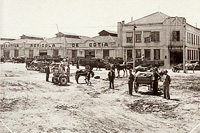Mega agricultural cooperatives – Cotia and Sul
Japanese immigrants made a great contribution to Brazil in agriculture fields among others. It was Japanese immigrants who spread the cultivation of potatoes, tomatoes, fruits and flowers as well as poultry farming.
It was two mega Japanese agricultural cooperatives, that is, the Cotia Industrial Cooperative and the Nanpaku Nogyo Kyodo Kumiai Chuokai (South Brazil Central Union of Agricultural Cooperatives), which promoted the development of Japanese farming. The two cooperatives dominated the Brazilian agriculture business in the post-war period.
Initial stage
Agricultural cooperatives began to be formed one after another in Japanese settlements in the late 1920s and 1930s. The reason is that the Consulate General of Japan in São Paulo encouraged formation of cooperatives on a model of agricultural cooperatives in Japan and provided grants for forming cooperatives.
Saku Miura, president of "the Nippaku Shimbun Sha" (Nippaku(Japan-Brazil) Newspaper Company), who ardently recommeded formig cooperatives, published in his newspaper, in September 1926, an article on visit entitled "The praise of potatoes" with a view of making potato producters at Cotia Village on the outskirts of São Paulo City form a cooperative. It was said that, because the potato producers did not have a warehouse to store their commodities, their products were bought on unreasonable low prices by merchants and that they should jointly build a warehouse. This article boosted the mood forming an agricultural cooperative. Kenkichi Shimomoto temporarily returned to Japan with money made from the potato boom from 1925 onwards and inspected activities of industrial cooperatives in his home Prefecture, Kochi. He led in starting a movement for forming a cooperative of potato ptoducers. On December 11, 1927, the Cotia Potato Producers Cooperative was established at Cotia Village. Two years later in December 1929, the Juqueri Agricultural Cooperative, a predecessor of Sul Brasil, was formed in the Juqueri area on the outskirts of São Paulo City.
Afterwards, in addition to potato cultivation, the cooperative also began to encourage cultivation of vegetables and changed its name to the Cotia Agricultural Cooperative (Cooperativa Agricola de Cotia (CAC)). The operational area of the cooperative was normally restricted to one distict, but it was expanded to the neighboring counties, and local offices were established to recruit new members of cooperatives. Thus, the cooperative which had only 83 members when first established grew to 1,303 members within 10 years of its establishment in 1937, and became the largest agricultural cooperative in Brazil.
In October 1934, when market brokers of São Paulo City launched a boycott of the purchases from the Cotia Cooperative, it went through the greatest ordeal. Acting jointly with non-affiliated producers, however, they won the State Government over to their side and took countermeasure to suspend the shipping of products to markets, which brought them victory.
In 1938, as the cooperative expanded their operational area to the whole state and producers in outlying regions who were seeking to ship their products to São Paulo City, the only major consume center in the state, joined it one after another, the cooperative grew further. During this period, the cooperative introduced Japanese techniques for poultry farming and made efforts to diffuse them.
Meanwhile, the Juqueri Cooperative was in a state of inner turmoil for the decade from its founding in 1929 onwards until 1939 when Gen'ichiro Nakazawa was elected executive director. For those years its number of members grew from 49 to only 93.
-
Articles in newspapers / magazines
Series of articles by Sakuzo Miura that urged formation of a cooperative
-
 View of the Cotia Agricultural Cooperative operated by a Japanese
View of the Cotia Agricultural Cooperative operated by a Japanese
Cooperatives during the war
With the end of diplomatic relations between Brazil and Japan after the outbreak of the Pacific War, the Cotia Agricultural Cooperative was engaged in food production, and since it was a domestic capital organization, it escaped the asset freezes. Although it was under control of a superivisor sent by the Government, it continued business operations. Any executive director of the cooperative was obliged to be a Brazilian and while other Japanese cooperatives were unable to find suitable Brazilians for the posts of directors, it successfully selected its legal counsel, Ferraz, as chairman. With the population growth of São Paulo State during the war years, it also grew. The number of its members increased from approximately 2,000 at the beginning of the war, to 3,000 by the end of war.
Postwar growth
The Cotia Agricultural Cooperative also continued to grow after the war. The number of its members surpassed 5,000 in 1952 and it expanded its business operations to the neighboring states. Meanwhile, in 1946 a new structure of the Juqueri Agricultural Cooperative which was composed of Angelo Zanini, chairman and Gen'ichiro Nakagawa, executive director started. Following the footsteps of the Cotia Agricultural Cooperative, it also grew rapidly. From 1951 onwards, it expanded its operations inland through the poultry and egg production. In 1954, it was renamed the Nanpaku Nogyo Kyodo Kumiai Chuokai (Cooperativa Central Agricola Sul-Brasil, South Brazil Central Union of Agricultural Cooperatives), and expanded its operations to Paranavai in the State of Parana in 1966. The both cooperatives helped spread the cultivation of flowers and fruit, in addition to the cultivation of potatoes and vegetables and poultry farming, in the postwar period.
In 1973, the Cotia Agricultural Cooperative sent cooperative members to tropical savannah climate regions spread across the States of Minas Gerais, Goias and Mato Grosso to settle in Serrado, and began the development of Serrado. In the second half of the 1980s, Cotia was composed of 14,470 personal members (1986), and Sul was composed of 40 individual cooperatives and 10,704 persons (1988).
Dissolution of the two cooperatives
Under the influence of agricultural and economic recession in the late eighties, however, the both cooperatives were saddled with heavy debt and ran into financial difficulties. The Sul ended its business operations on March 30, 1994, followed by the Cotia on September 30 of the same year. It had a huge impact on the Japanese community.









